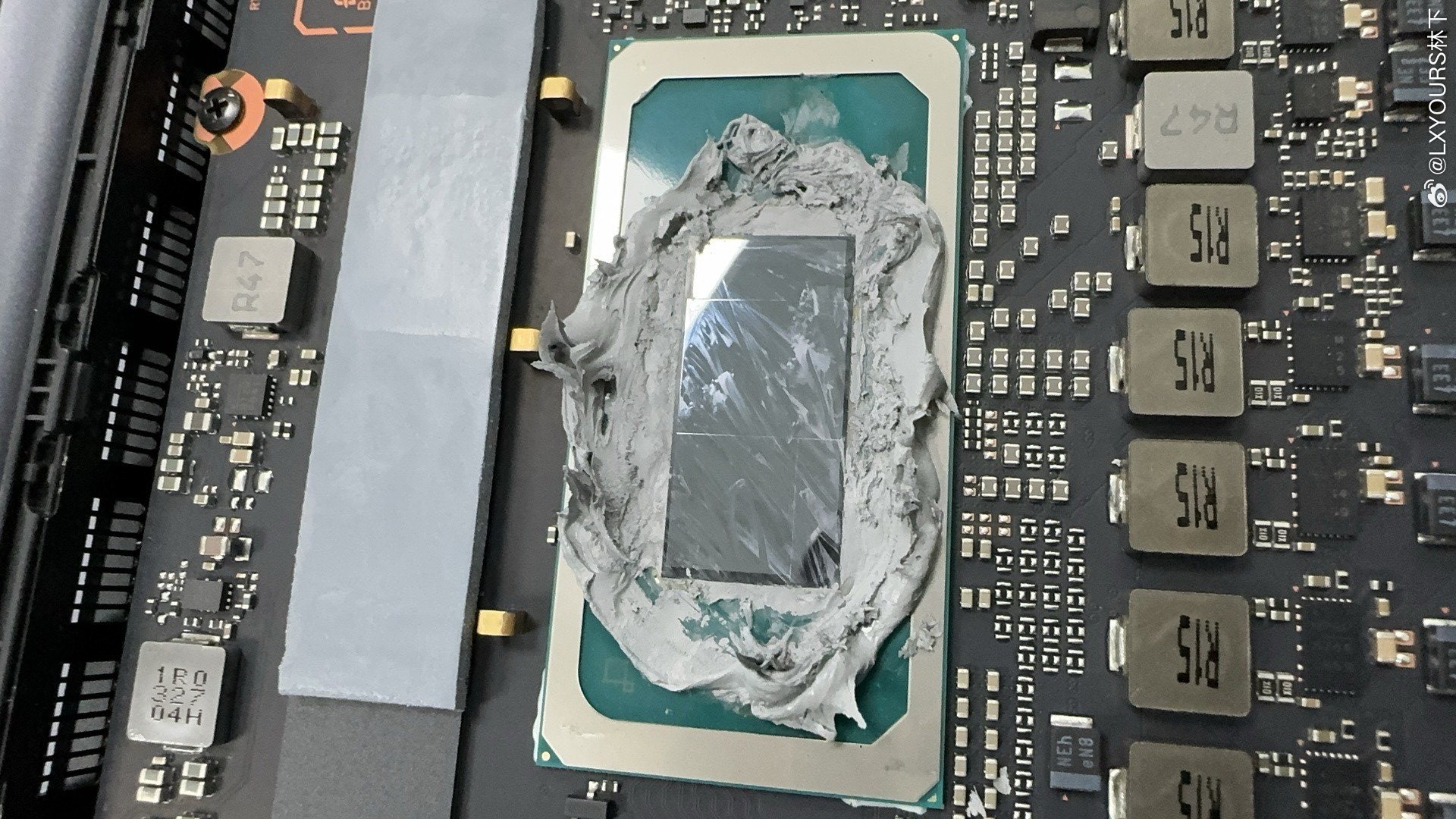Meteor Lake laptop chip performs like Ryzen 7 desktop PC chip in leaked benchmark — next-gen 16-core Ultra 9 185H flaunts 5.1 GHz at 45W
A small taste of the Core Ultra 9 185H's flagship performance

A Weibo user has leaked images and system specifications of Samsung's upcoming Galaxy Book 4, which uses Intel's Core Ultra 9 185H Meteor Lake CPU (via @9550pro on X). The leak includes clear images of the internal layout of the Galaxy Book 4 (presumably the Ultra model) and screenshots from CPU-Z.
Unfortunately, we didn't get much benchmarking data from this leak since the leaker was, in their own words, "too lazy to run" benchmarks. They did share a CPU-Z benchmark result, and the performance is roughly on par with AMD's Ryzen 7 7700X. However, CPU-Z's built-in test isn't known for being great, so drawing early conclusions based on this single data point is probably not a good idea.
Although the Weibo user didn't specify what laptop he was showing off, it's all but sure the laptop is Samsung's Galaxy Book 4, which is rumored to be announced on December 15. The internal layout of the leaked laptop is highly similar to that of the Galaxy Book 3 Ultra, which has the same color scheme on the PCB, the exact placement of M.2 slots and USB ports, and even near-identical cable routing.
According to the leak, this Galaxy Book 4 is equipped with the Core Ultra 9 185H and Nvidia's RTX 4070, paired with an improved vapor chamber cooler. The laptop also has Power Delivery 3.1 charging and uses a 140-watt charger. We can also guess the computer has the same ports as the Galaxy Book 3 Ultra: HDMI, Micro SD, 3.5mm audio, a single USB Type-A port, and two Thunderbolt 4 ports.
The CPU-Z screenshot reveals that the Core Ultra 9 185H has a 45-watt TDP, which is standard for Intel's H-class chips. We also see that the CPU uses the C0 stepping, which indicates what version of Meteor Lake the chip operates. Steppings are organized by letter (a distinct version) and divided by number. If you're familiar with software updates for games or GPU drivers, C0 means version 3.0.
A stepping of C0 implies a somewhat longer development process than usual. For comparison, Ryzen 7000 Raphael chips use the B2 stepping, Ryzen 5000 Vermeer CPUs initially used the B0 stepping but later moved to B2, and Intel's Raptor Lake processors are all on B0. Alder Lake CPUs had a stepping of C0, much like Meteor Lake, and there are parallels between the two chips. Alder Lake was developed on the troubled Intel 7 (formerly 10nm) node, and Meteor Lake is the first CPU to use the Intel 4 (previously 7nm) node, which also saw its development issues.
Intel will announce Meteor Lake on December 14, so corresponding laptops should be around the corner.
Get Tom's Hardware's best news and in-depth reviews, straight to your inbox.

Matthew Connatser is a freelancing writer for Tom's Hardware US. He writes articles about CPUs, GPUs, SSDs, and computers in general.
-
Роман What I see on image on top of article?Reply
Why so much thermal?
And what actually covered chip? -
ingtar33 that sounds like a bugged result, because other leaks directly contradict these results badly, with a much wider group of tests.Reply -
Reply
Steppings are organized by letter (a distinct version) and divided by number. If you're familiar with software updates for games or GPU drivers, C0 means version 3.0.
A stepping of C0 implies a somewhat longer development process than usual. For comparison, Ryzen 7000 Raphael chips use the B2 stepping, Ryzen 5000 Vermeer CPUs initially used the B0 stepping but later moved to B2, and Intel's Raptor Lake processors are all on B0. Alder Lake CPUs had a stepping of C0, much like Meteor Lake, and there are parallels between the two chips.
You might need to check some of the data on the CPU’s “stepping” and the revision of the silicon. Apart from being in a longer development process, a letter change could also signify a change to both the base layer mask revision and metal layers, whereas a change in the number could indicate a change in the metal layer mask revision only, in Intel’s terminology.
But for consumers and end-users the stepping/revision number is not THAT much of an issue while purchasing new silicon.
But in any case, not all Ryzen 7000 Raphael chips use the B2 stepping. Check the database and spec sheets again. Also, the statement, “Intel's Raptor Lake/RPL processors are all on B0” is also not accurate.
Some of the SKUs in the final RPL lineup sport the previous Alder Lake C0 silicon. Few processors also use the H0 die.
The same is true for Alder Lake-S/ADL as well. Alder Lake CPUs didn’t just have a stepping of C0 either. For example, the final Retail version of the Intel Alder Lake-S 6-core i5-12400 CPU uses the C0 silicon, even though there is one more variants in the market, sporting both the H0 silicon die.
There are more SKUs as well.
Basically for the ADL lineup, two silicon stepping variations were used, C0 and H0, which showcased both the 8+8 full core implementation (C0), with the slimmer variation lacking the smaller Efficient cores (H0 die).
Btw, the 10-core Alder Lake-K SKU sports the C0 silicon stepping (i5-12600K), and one using a lesser 6-core non-K SKU is based on the H0 silicon stepping (i5-12600).
https://i.imgur.com/TJtt23q.jpg -
DavidC1 Reply
The author's assumptions are correct in this case.Metal Messiah. said:You might need to check some of the data on the CPU’s “stepping” and the revision of the silicon.
Raptorlake had a very fast development time with little issues. Meteorlake went through a lot of troubles. So is Sapphire Rapids. Granite Rapids and Sierra Forest(to a lesser degree) has been in development for quite some time too, including move from Intel 4 to 3.
Emerald Rapids is coming earlier despite the fact that it's been developed quite a bit later than either server chips.
Sapphire Rapids development was at a time when Intel fired the entire server validation team at one point. -
JayNor Nope, all indications are that Intel isn't repeating anything like the 10nm problems in Intel-4.Reply
Alder lake was Intel's 4th consumer chip on 10nm, btw.
If the process were to blame, then we'd be having a Cannon Lake moment and we wouldn't be seeing stories on Samsung Galaxy Book 4. -
cyrusfox Multithread beats most 8 core/16 thread cpuz results, but the real win is how well single core is performingReply
Its score of 767 ties the 7950x, and trounces any AMD mobile chip. Only a 4.5% uplift over the 12900H, so meteor still bringing Gen on Gen improvements, although a bit underwhelming.
Need to see real world battery usage + constrained performance test to see how it stacks against Apple M1/M2/M3